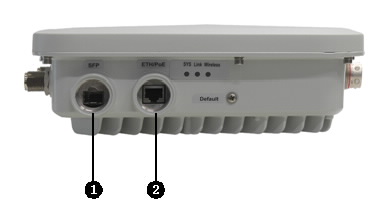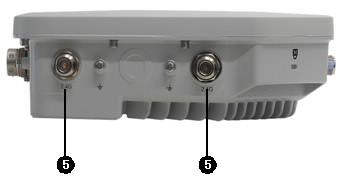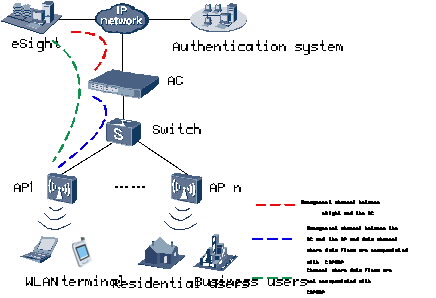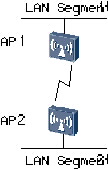AP6610DN Outdoor Dual-band AP
The AP6610DN supports 2.4 GHz and 5 GHz frequency bands, and has enhanced coverage performance and protection capabilities. It supports wireless bridging, complies with IEEE 802.11a/b/g/n,connects a large number of users, and works as a Fit AP.

Highly reliable wireless access
- Complies with IEEE 802.11a/b/g/n
- Provides a maximum rate of 300 Mbit/s for each radio
- Uses Wi-Fi Multimedia (WMM) to implement priority scheduling based on the service type (voice, video, or data), and implements end-to-end QoS through priority mapping on wireless and wired interfaces
- Supports wired link integrity check
- Supports load balancing
- Supports roaming without service interruptions
- Supports AC hot standby
- Supports the beamforming technique
- Uses the latest 802.11n chip to increase the performance by 20%
- Has a strong coverage capability
- Uses a metal shell and a design that dissipates heat for high reliability
Comprehensive user access control capability
- Supports access control lists (ACLs) and user access controls based on user group policies
- Provides per-user bandwidth management
- Supports user isolation policies
High security
- Wired Equivalent Privacy (WEP)
- Wi-Fi Protected Access (WPA)/WPA2
- WLAN Authentication and Privacy Infrastructure (WAPI)
- 802.1x
- Detection of unauthorized APs
Flexible networking and environment adaptability
- For use in Fit AP and WDS networking scenarios
- Automatically selects the transmission rate, channel, and transmit power to adapt to multiple radio environments and limit interference in real time
- Adjusts bandwidth allocation based on the number of users and radio environment
- Supports the MIMO antenna system and connects to external dual-band antennas (2.4 GHz and 5 GHz). You can adjust the antennas based on the radio environment
Simple device management and maintenance
- Automatically discovers ACs and loads the AC (plug-and-play) configuration
- Supports batch upgrade
- Monitored by the NMS in real time. You can remotely configure APs and locate faults on APs using the NMS
- Supports the Link Layer Discovery Protocol (LLDP) to implement automatic link discovery and obtain the network topology
High reliability and protection level
- Uses efficient hardware protection measures
- Supports wide variations in temperate from -40℃ to +60℃
- Uses industry-standard components
- Provides IP66 protection level
- Has built-in 5 kA surge protection and requires no external surge protection devices. This simplifies installation and lowers costs
- Provides 6 kA/6 kV surge protection capability on an Ethernet interface
- Provides 20 kA surge protection on an AC power port, without external AC surge protection devices
- Complies with international standards
- Supports uplink optical ports
WLAN features
- Compliance with IEEE 802.11a/b/g/n, providing a maximum rate of 300 Mbit/s for each radio
- Priority mapping and packet scheduling based on a Wi-Fi Multimedia (WMM) profile to implement priority-based data processing and forwarding
- Automatic and manual rate adjustment (the rate is adjusted automatically by default)
- WLAN channel management and channel rate adjustment
- Automatic channel scanning (the AP6610DN scans channels used by other APs, measures their interference, and reports the scanning result to the AC to trigger channel adjustment)
- Service set identifier (SSID) hiding
- Signal sustain technology (SST)
- STA power-saving mode
- Control and Provisioning of Wireless Access Points (CAPWAP)
- Automatic AC discovery
Network features
- Compliance with IEEE 802.3u
- Ports: Auto-negotiation of the rate and duplex mode and automatic switching between the Media Dependant Interface (MDI) and Media Dependant Interface Crossover (MDI-X) mode
- 1024 unicast MAC addresses
- VLAN assignment based on SSIDs
- VLAN aggregation on uplink Ethernet ports
- 4093 VLAN IDs (1-4093) and 16 virtual APs (VAPs)
- Uplink ports in tagged and untagged mode
- DHCP client
- PPPoE dialup
- Centralized data forwarding and local data forwarding
- STA isolation in the same VLAN
- ACL
- LLDP
QoS features
- Priority mapping and packet scheduling based on WMM profiles to implement priority-based data processing and forwarding
- WMM parameter management for each radio frequency
- WMM power saving
- Priority mapping for upstream packets and flow-based mapping for downstream packets
- Queue mapping and scheduling
- User-based bandwidth limiting
- Adaptive bandwidth allocation (the system dynamically adjusts bandwidth based on the number of users and radio environment)
Security features
- Open system authentication
- WEP authentication/encryption
- WPA/WPA2 authentication and encryption
- 802.1x authentication and encryption
- WAPI authentication and encryption
- SMS4 decryption for data packets
- Wired link integrity check (the AP stops sending radio signals if the tunnel between the AP and AC is terminated)
Maintenance features
- AP management and maintenance by the AC
- Plug-and-play: automatic AC discovery and automatic configuration loading
- Batch upgrade
- Debugging using Telnet and the serial interface
- Real-time configuration monitoring and fast fault location by using the NMS
- System status alarm
Specifications
Antenna Parameters
Table
Appearance
Ports

1. SFP: optical port.
2. ETH: 10/100/1000M port, which connects to the Ethernet network.

3. Ground point: connects to a ground cable.
4. Power input port: 100–240 V AC.

5. 2.4 GHz antenna port.

6. 5 GHz antenna port.
LED Indicators
| Information Type | SYS LED | Link LED | WiFi LED | Description |
|---|---|---|---|---|
| Startup status | Steady green | Off | Off | The device is being started. |
| Blinking green | Off | Off | The system is working properly. | |
| Steady red | Off | Off | The system fails to load the DRAM or system software. | |
| Blinking (0.5Hz) | Off | Off | The system is working properly, but the Ethernet is not connected and radios or all VAPs are disabled. | |
| Blinking green | The system is working properly, but the Ethernet is not connected. The wireless indicator blinks more quickly as more packets are received on the 2.4 GHz air port. | |||
| Blinking yellow | The system is working properly, but the Ethernet is not connected. The wireless indicator blinks more quickly as more packets are received on the 5 GHz air port. | |||
| Blinking green and yellow alternately | The system is working properly, but the Ethernet is not connected. STAs at 2.4 GHz and 5 GHz are connected. | |||
| Blinking (0.5Hz) | The indicator is steady green if no data is transmitted. The indicator blinks green more quickly when more packets are transmitted. | Off | The system is working properly, but the Ethernet is not connected and radios or all VAPs are disabled. | |
| Blinking green | The system is working properly, but the Ethernet is not connected. The wireless indicator blinks more quickly as more packets are received on the 2.4 GHz air port. | |||
| Blinking yellow | The system is working properly, but the Ethernet is not connected. The wireless indicator blinks more quickly as more packets are received on the 5 GHz air port. | |||
| Blinking green and yellow alternately | The system is working properly, but the Ethernet is not connected. STAs at 2.4 GHz and 5 GHz are connected. |
The AP6610DN is recommended for use in residential or commercial properties without wired resources. The AP6610DN APs can be deployed at both ends of a commercial street or in the building opposite to a commercial property. The APs must be equipped with external antennas to implement wireless signal coverage.
Fit AP networking:

In this networking, the AP6610DN functions as a Fit AP that provides only data forwarding functions. The AC is responsible for user access, authentication, AP management, and configurations of security protocols, routing, and QoS.
WDS networking (point-to-point):

WDS networking (point-to-multipoint):
In this networking, the AP6610DN connects two or more independent wired or wireless LANs through wireless links. In a Wireless Distribution System (WDS), the AP6610DN supports point-to-point, point-to-multipoint, and multipoint-to-multipoint networking modes. The AP implements wireless bridging and access functions using 5 GHz and 2.4 GHz frequency bands.
Utiles Produits
- AP7130DN-AC Indoor Dual-band AP
- AP7030DN-AC Indoor Dual-band AP
- AP5010DN-AGN Indoor Dual-band AP
- AP5010SN-GN Indoor Single-band AP
- AP7110DN-AGN Indoor Dual-band AP
- AP7110SN-GN Indoor Single-band AP
- AP6010SN Indoor Single-band AP
- AP6010DN Indoor Dual-band AP
- AP6310SN Indoor distributed Single-band AP
- AP6510DN Outdoor Dual-band AP




















